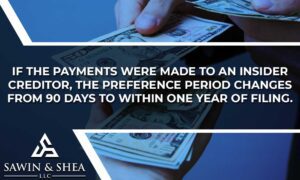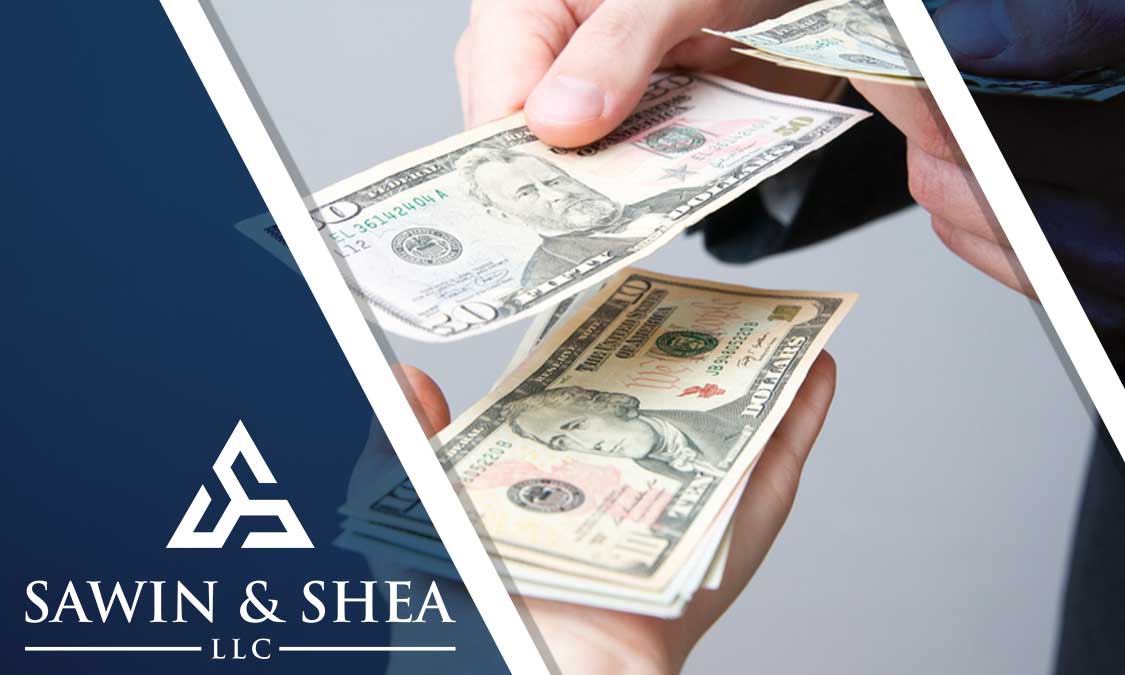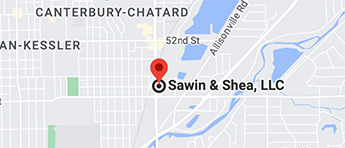Before someone makes a bankruptcy filing, it is not uncommon for debtors to feel as if they have to make some tough decisions. Which creditors can they pay? Which ones will not get the payment they’re owed?
This typically occurs because the debtor doesn’t have the money to pay all of their creditors, so they feel they need to rank which ones are more important to pay first. Maybe they got a tax refund and wanted to use the money to pay down some of their debt, or they sold some possessions in hopes of getting the debt under control.
They might give preference to the more aggressive creditors or try to pay off old debt first, but they choose to get one debt paid above all the rest. Under ordinary business terms, that’s sensible. But this decision to prioritize paying a single creditor over another can complicate their case should they decide to start bankruptcy paperwork.
When payments are made to some creditors over others, they can be considered preferential payments according to bankruptcy laws. Though a debtor may have just been trying to do what they thought was best, the bankruptcy court and the bankruptcy trustee may not see it that way.
The preferential payment rule exists to protect creditors, ensuring that they get what they’re owed in the event of bankruptcy. The bankruptcy trustee assigned to the debtor’s case will ensure equal distribution of the bankruptcy estate so that all creditors are paid the maximum amount possible.
Bankruptcy Filing and Preference Payments
When a debtor decides that the best way forward is filing bankruptcy, that’s not a decision that is undertaken lightly. To determine the best way to proceed, and whether Chapter 7 or Chapter 13 bankruptcy are right for you, you should meet with an experienced bankruptcy lawyer.
A bankruptcy lawyer can help you create a strategy to protect your assets and ensure that your bankruptcy petition goes as smoothly as possible.
Before you decide to make any payment that could potentially be construed as a preference payment, consult your attorney. They’ll help you avoid potential pitfalls within the bankruptcy code.
Bankruptcy Code on Preferential Payment

Bankruptcy law is in place to ensure all creditors are paid fairly and to prevent creditors from unfairly pursuing debtors at the expense of other creditors.
If you file for bankruptcy and the court determines that you prioritized paying a creditor over others, the bankruptcy trustee assigned to oversee your case could go to the preferred creditor, get the funds back, and distribute them evenly amongst your creditors.
When a debtor makes a transfer— defined as money paid or a non-monetary act, such as returning goods to the original creditor— to a creditor that qualifies as a preferential transfer, it can be reversed by the bankruptcy trustee to ensure that other creditors are paid.
Preferential payments include:
- Payments made to one creditor on a debt that existed before the time the payment was made.
- Payments exceeding $600 in the 90 days before filing, known as the preference period or look back period
- Payment amounts exceeding the amount that the creditor would have received in bankruptcy
- Payment not made in exchange for new value
- Payment not made in the ordinary course of business or financial affairs between the debtor and the payee
Additionally, the code specifies that these payments must have been made to a “non-insider” creditor. Insider creditors include a friend, family, member, or business associate.
If the payments were made to an insider creditor, the preference period changes from 90 days to within one year of filing.
Secured vs. Unsecured Creditor
A secured creditor has a lien of some kind on a debtor’s property. Bank-owned assets that have a recurring monthly payment, like mortgage payments or an auto loan fall under this category. They can repossess the assets in question if the debtor is delinquent in payment, so there’s less risk in making the loan.



If the debtor’s payment history is in good stead, their assets owned by a secured creditor are safe— their home or their car, for example.
Unsecured creditors lend money without any collateral. These debts are higher risk, as they have nothing to seize if the debtor doesn’t make regular payments.
A good example of this type of creditor is a credit card company; they extend borrowers credit without requiring any collateral. Other regular creditors include utility companies, landlords, doctors or hospitals. Family members. business, or even a general partner, classified as insider creditors, are classified as other unsecured creditors.
Of course, failure to pay unsecured creditors can negatively impact a bankruptcy filer; it can impact their credit score, making it hard to secure other loans. However, these creditors cannot seize assets if they haven’t received payment within the requisite time period.
Preferential Payment Reversals: A.K.A Clawbacks



According to preference rules, the trustee assigned to your bankruptcy case can review the financial transactions that occurred before filing for bankruptcy.
If any payments made to creditors during the preference period are classified as preferential transfers, the trustee assigned to your case can reverse these payments through a preference claim, also known as a clawback.
Preference suits revert any payments deemed to the debtor’s bankruptcy estate. Then, all the funds available will be evenly distributed amongst all creditors, as the trustee demands. Clawback or preference claims are considered a central proceeding in bankruptcy cases.
Not everything can be resolved by a judge in a bankruptcy case unless it is a central proceeding, meaning clawback procedure can and will be resolved in the Bankruptcy Court. There is no way to avoid it if preference payments were made.
Once the money is secured after the preference suit, the trustee will begin distributing funds.
Exceptions to Preference Payment Claims
Of course, a creditor who has been paid won’t be eager to give back money paid by the debtor, even if it could potentially be considered a preference payment. There are exceptions that businesses can claim to keep the money they were paid.
These include:
- If the money was paid in a “contemporaneous exchange for new value,” the subsequent transfer might not be categorized as a preferential transfer. In other words, if the debt incurred was for something new, not an old debt or antecedent debt, it would be classified as a contemporaneous exchange.
- Payments made to regular creditors in the “ordinary course of business” wouldn’t be considered preference payments. If, for example, a debtor had a recurring order set up for their business and, historically, the debtor pays for this order within 30 days and that 30-day payment window is considered to be standard for the industry, payments made within the preference period will likely stand. It’s considered part of the ordinary course of business and the defense applies.
- If a payment was made for a “subsequent transfer of new value,” it could be ineligible for clawback. For instance, if a debtor makes a $30,000 payment to a creditor for an old debt that wasn’t classified as the ordinary course of business, that would be classified as preferential payment. However, if the same creditor provided the debtor with $20,000 of product after that payment was made but the debtor in possession of the product did not make an additional payment, they could argue that they should be able to keep $20,000 of the original $30,000 payment to cover this newly incurred debt.
If a creditor can prove any of the exceptions above, they could be permitted to keep the money paid to them.
Of course, a debtor wants to ensure that all their creditors are paid for services rendered, but the bankruptcy laws must be carefully followed. An experienced bankruptcy attorney can help navigate these challenges.
Avoiding Preference Payment in the Future
Though making a preferential payment is not illegal, and you will not get in trouble for doing so, it is best avoided when possible.
The only time a debtor can face charges for making preferential payments is if they intentionally made them to defraud a creditor or hide money. In this case, you may face criminal charges and risk losing the benefit of having your debt discharged through a bankruptcy filing.
Typically, however, most debtors make preferential payments without realizing they are doing so or because they feel they have no other option. If they have enough money to discharge a debt, they believe it’s the best thing to do under the circumstances.
You will not be punished in these cases, but if you think that you may file for bankruptcy again at some point, it is something to keep in mind when you are determining how to pay each creditor.
How Sawin & Shea, LLC Can Help
If you are concerned about preferential payment affecting your bankruptcy case and aren’t sure what to do, it can be helpful to consult an experienced bankruptcy attorney.
Bankruptcy lawyers handle cases like this every day and will know how to guide you through the process to ensure everything is done correctly.
At Sawin & Shea, we believe in providing compassionate and understanding representation to all of our clients who file for bankruptcy and are determined to help you achieve the best possible outcome.
Our attorneys are highly experienced in bankruptcy cases and are here to help you through the process every step of the way.
If you have any questions about filing for bankruptcy, contact us at 317-759-1483 or send us an email for a free consultation.



